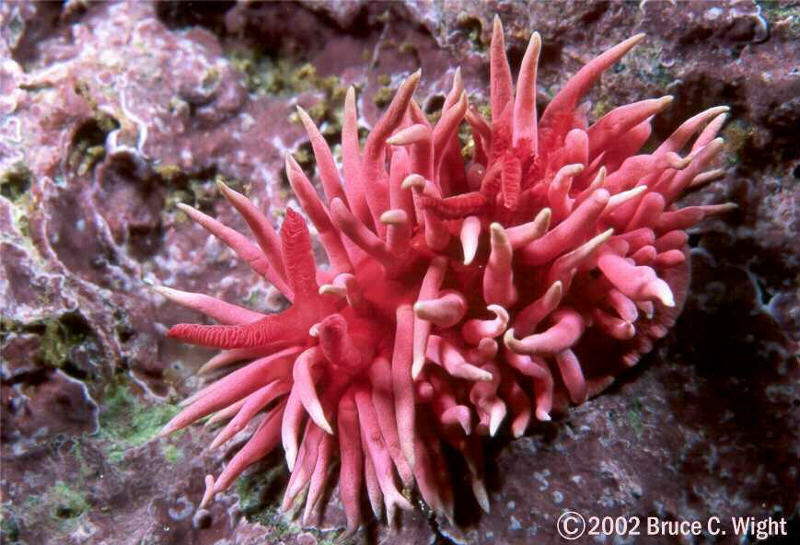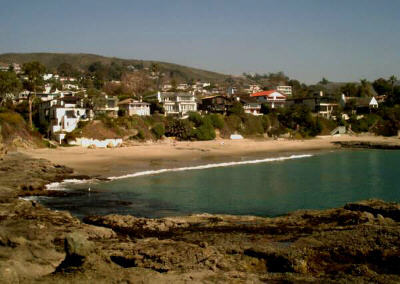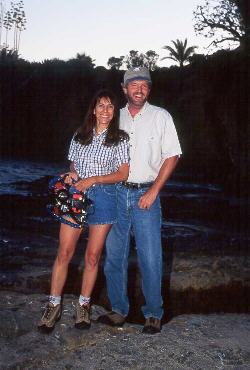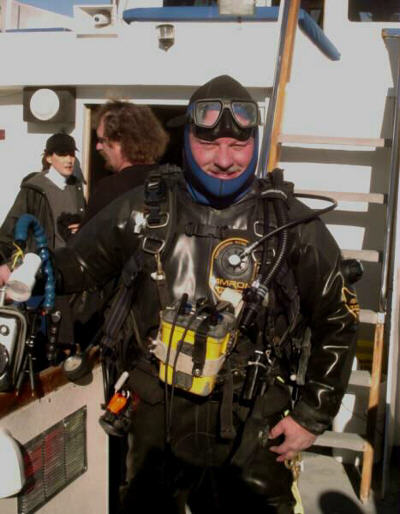 |
Hopkinsia rosacea
MacFarland, 1905Courtesy of Bruce and Johanna Wight
Shaw's Cove, Laguna Beach, Calif
Photo of Shaw's Cove courtesy of Alan Grant

|
Just north of the Main Beach area of Laguna Beach are a series of coves popular for divers. Shaw's Cove is located to the ocean side of Laguna Sea Sports , a popular dive shop in the area. Street parking above the cove can be crowded in Summer, available during Winter. The cove is reached by a short flight of stairs to the beach. Reefs encircle the sandy cove at each side, but the west, or right-hand reef is most popular. The cove suffers extremely high use during the Summer months with "check-out" classes from dive shops from many counties. During the fall and winter, however, the sunbathing and dive class crowds are gone, and dive opportunities are better. When Santa Ana winds blow during high pressure, combined with breaks between winter storms and swell and surf activity, the cove becomes magical. Visibility can exceed 40 ft. and it becomes safe to explore the many narrow underwater channels, caves, and shallow structures of the west reef. The reef projects into the nearshore currents and traps many passing organisms which settle out and display themselves within easy access from shore.
In particular, there are a multitude of nudibranchs which call Shaw's Cove home. Some are seldom seen, some are seasonal and some are common year round. The secret of branching in this area is to focus small and look at the details of the reef. When looking for invertebrates, one must understand their behavior and what they feed on. Once this is known, it is just a matter of finding a location that satisfies this profile. The more one learns about the animal and it's behavior, the easier it is to locate. It also helps to put a good coating of defogger on your mask before starting the dive! |

|
Aplysia californica is, without a doubt, the most common opisthobranch at Shaw's. It can be found all over the reef grazing on the algae on the rocks. In summer, A. vaccaria can be found as well. Tylodina fungina is found nestled in encrustations of yellow sulfur sponge, in typical cryptic camoflage. Laila cockereli is fairly common and a couple can be found on a single dive if one inspects the mussel shell debris on the bottom of the main channel and the margin of the reef a foot or two above the sand. Hopkinsia rosacea is seasonally common feeding on Erystomella , the bryozoan which imparts the characteristic red and pink coloration to the nudibranch. It can be found in the rocky cracks off the main channel, just past a beautiful underwater arch formation. For some reason, these animals seem to hang out in pairs (could it be the desire to mate?). Polycera atra is another seasonally common animal that is found feeding on Bugula, a small brown shrub-like hydroid, on the reef deeper than 20 ft. The taletale clue are white egg ribbons of
Send Bruce and Johanna email at bwproductions@earthlink.net |
Alan seen getting ready for Channel Islands dive or is he getting ready
to go to the moon with all that gear?

I've been asked to comment about my hobby of capturing nudibranchs and other marine invertebrates of Shaw's Cove and other locations on video. When one looks at the nearshore environment underwater, particularly in areas that are stressed by the urban interface in Southern California, it is easy to see why new recreational divers become "burned out" quickly. "Just a bunch of boulders surrounded by urchin barrens and mussel fields and a few Garibaldi" is a common observation. How easy it is to cruise over the substrate and never notice the intricate interrelationships going on. For those who take up underwater photography, most soon learn that the macro world presents some of the most colorful images, especially in waters with limited visibility. Once I discovered this for myself, I gravitated toward looking for the small things. Next I discovered how to put magnifying diopters in front of a camcorder to make it actually magnify images larger than can be seen by the human eye, thereby revealing details unseen by even the most observant diver. Nudibranchs and other even more stationary or sessile organisms became subjects, because, unlike fish, they weren't skittish. The more I looked, the more I wondered how to find other treasures. Soon I was purchasing wonderfully illustrated picture guidebooks (Sea Challengers ) and other marine textbooks, and even getting help from marine scientist and underwater photographer friends with clues on animal behavior and ecological niches, etc. The most wonderful and rewarding experience of all, however, was that the whole process caused me to slow my entire dive process down. Instead of madly chasing over the substrate, I now crawl along very slowly, trying to take in every detail. I have been able, through the help of my guidebooks and my friends, to have more knowledge of where to look to find the subjects I wish to make videos of. Branching photography still presents a daunting challenge, just to find the critters, then to have them in a pose or an activity which displays their morphology best, or tells a story about their life cycle. Macro video presents an additional challenge, because the housing must be held as motionless as possible for the 5-10 seconds of the typical clip length. At high magnification, the depth of field is only 1/8 inch. Add to this current, lack of a handhold, and backscatter, adjusting the lighting, white balance, focus and composition, along with all the normal problems with dead batteries, o-rings, scratches and fogging on ports, etc. and one begins to understand the masochistic nature of this endeavor. The reward, however, is an occasional video clip of something that few others get to see, something which displays the wonderful diversity of form and color patterns that all opisthobranch lovers know, beautiful creatures in full motion! |
Laguna Beach, Calif
Feb., 2002
Send Alan email at dentadive@cox.net
